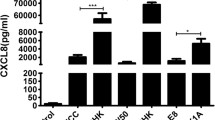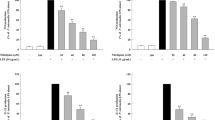Abstract
Gingipains secreted by Porphyromonas gingivalis (P. gingivalis, Pg) play an important role in maintaining macrophage infiltrating. And, this study is to evaluate effects of gingipain on M1 macrophage polarization after exposure to Porphyromonas gingivalis (P. gingivalis, Pg) and if these effects are through complement component 5a (C5a) pathway. Mouse RAW264.7 macrophages were exposed to gingipain extracts, Escherichia coli lipopolysaccharides (Ec-LPS), Pg-LPS with or without the C5aR antagonist: PMX-53 for 24 h. Then, gene expressions and protein of IL-12, IL-23, iNOS, IL-10, TNF-α, IL-1β, and IL-6 were determined by qRT-PCR and ELISA assays. Surface markers CD86 for M1 and CD206 for M2 were also evaluated by flow cytometry. The results show that gingipain extracts alone increased expressions of IL-12, IL-23, iNOS, TNF-α, IL-1β, and IL-6, but not IL-10. Gingipain extracts plus Ec-LPS decreased expressions of IL-12, IL-23, iNOS, TNF-α, IL-1β, and IL-6 in which Ec-LPS induced increase. For gingipain extracts plus Pg-LPS-treated RAW264.7, macrophages, gingipain extracts enhanced expressions of IL-12 and IL-23 in which Pg-LPS induced increase, but not iNOS and IL-10 while gingipain extracts decreased expressions of TNF-α, IL-1β, and IL-6 in which Pg-LPS induced increase. Interestingly, PMX-53 increased expressions of IL-12, IL-23, and iNOS when RAW264.7 macrophages were treated with gingipain extracts plus Ec-LPS or Pg-LPS and PMX-53, while PMX-53 decreased expressions of TNF-α, IL-1β, and IL-6. Changes of CD86-positive macrophages were consistent with cytokine changes. Our data indicate that gingipain is a critical regulator, more like a promoter to manipulate M1 macrophage polarization in order to benefit P. gingivalis infection through the C5a pathway.






Similar content being viewed by others
References
Akira S, Takeda K (2004) Toll-like receptor signalling. Nat Rev Immunol 4:499–511
Akiyama T, Miyamoto Y, Yoshimura K, Yamada A, Takami M, Suzawa T, Hoshino M, Imamura T, Akiyama C, Yasuhara R, Mishima K, Maruyama T, Kohda C, Tanaka K, Potempa J, Yasuda H, Baba K, Kamijo R (2014) Porphyromonas gingivalis-derived lysine gingipain enhances osteoclast differentiation induced by tumor necrosis factor-α and interleukin-1β but suppresses that by interleukin-17A: importance of proteolytic degradation of osteoprotegerin by lysine gingipain. J Biol Chem 289:15621–15630
Assuma R, Oates T, Cochran D, Amar S, Graves DT (1998) IL-1 and TNF antagonists inhibit the inflammatory response and bone loss in experimental periodontitis. J Immunol 160:403–409
Bainbridge BW, Coats SR, Darveau RP (2002) Porphyromonas gingivalis lipopolysaccharide displays functionally diverse interactions with the innate host defense system. Ann Periodontol 7:29–37
Bostanci N, Belibasakis GN (2012) Porphyromonas gingivalis: an invasive and evasive opportunistic oral pathogen. FEMS Microbiol Lett 333:1–9
Curtis MA, Aduse-Opoku J, Rangarajan M (2001) Cysteine proteases of Porphyromonas gingivalis. Crit Rev Oral Biol Med 12:192–216
Darveau RP (2010) Periodontitis: a polymicrobial disruption of host homeostasis. Nat Rev Microbiol 8:481–490
Deng S, Jepsen S, Dommisch H, Stiesch M, Fickenscher H, Maser E, Chen H, Eberhard J (2011) Cysteine proteases from Porphyromonas gingivalis and TLR ligands synergistically induce the synthesis of the cytokine IL-8 in human artery endothelial cells. Arch Oral Biol 56:1583–1591
Edwards JP, Zhang X, Frauwirth KA, Mosser DM (2006) Biochemical and functional characterization of three activated macrophage populations. J Leukoc Biol 80:1298–1307
Eke PI, Dye BA, Wei L, Slade GD, Thornton-Evans GO, Borgnakke WS, Taylor GW, Page RC, Beck JD, Genco RJ (2015) Update on prevalence of periodontitis in adults in the United States: NHANES 2009 to 2012. J Periodontol 86:611–622
Fokkema SJ (2010) Peripheral blood monocyte responses in periodontitis. Int J Dent Hyg 10:229–235
Gordon S, Martinez FO (2010) Alternative activation of macrophages: mechanism and functions. Immunity 32:593–604
Graves D (2008) Cytokines that promote periodontal tissue destruction. J Periodontol 79:1585–1591
Grenier D, Tanabe S (2010) Porphyromonas gingivalis gingipains trigger a proinflammatory response in human monocyte-derived macrophages through the p38α mitogen-activated protein kinase signal transduction pathway. Toxins (Basel) 2:341–352
Guo Y, Nguyen KA (2000) Potempa J (2010) dichotomy of gingipains action as virulence factors: from cleaving substrates with the precision of a surgeon’s knife to a meat chopper-like brutal degradation of proteins. Periodontol 54:15–44
Hajishengallis G, Lambris JD (2010) Crosstalk pathways between toll-like receptors and the complement system. Trends Immunol 31:154–156
Hajishengallis G, Liang S, Payne MA, Hashim A, Jotwani R, Eskan MA, McIntosh ML, Alsam A, Kirkwood KL, Lambris JD, Darveau RP, Curtis MA (2011) Low abundance biofilm species orchestrates inflammatory periodontal disease through the commensal microbiota and complement. Cell Host Microbe 10:497–506
Hajishengallis G, Darveau RP, Curtis MA (2012) The keystone-pathogen hypothesis. Nat Rev Microbiol 10:717–725
Holden JA, Attard TJ, Laughton KM, Mansell A, O’Brien-Simpson NM, Reynolds EC (2014) Porphyromonas gingivalis lipopolysaccharide weakly activates M1 and M2 polarized mouse macrophages but induces inflammatory cytokines. Infect Immun 82:4190–4203
Jain S, Coats SR, Chang AM, Darveau RP (2013) A novel class of lipoprotein lipase-sensitive molecules mediates TLR2 activation by Porphyromonas gingivalis. Infect Immun 81:1277–1286
Kendall HK, Marshall RI, Bartold PM (2001) Nitric oxide and tissue destruction. Oral Dis 7:2–10
Kolev M, Le Friec G, Kemper C (2014) Complement--tapping into new sites and effector systems. Nat Rev Immunol 14:811–820
Krausgruber T, Blazek K, Smallie T, Alzabin S, Lockstone H, Sahgal N, Hussell T, Feldmann M, Udalova IA (2011) IRF5 promotes inflammatory macrophage polarization and TH1-TH17 responses. Nat Immunol 12:231–238
Lam RS, O’Brien-Simpson NM, Lenzo JC, Holden JA, Brammar GC, Walsh KA, McNaughtan JE, Rowler DK, Van Rooijen N, Reynolds EC (2014) Macrophage depletion abates Porphyromonas gingivalis-induced alveolar bone resorption in mice. J Immunol 193:2349–2362
Lawrence T, Natoli G (2011) Transcriptional regulation of macrophage polarization: enabling diversity with identity. Nat Rev Immunol 11:750–761
Maekawa T, Krauss JL, Abe T, Jotwani R, Triantafilou M, Triantafilou K, Hashim A, Hoch S, Curtis MA, Nussbaum G, Lambris JD, Hajishengallis G (2014) Porphyromonas gingivalis manipulates complement and TLR signaling to uncouple bacterial clearance from inflammation and promote dysbiosis. Cell Host Microbe 15:768–778
Moncada S, Palmer RM, Higgs EA (1991) Nitric oxide: physiology, pathophysiology and pharmacology. Pharmacol Rev 43:109–142
Moskow BS, Polson AM (1991) Histologic studies on the extension of the inflammatory infiltrate in human periodontitis. J Clin Periodontol 18:534–542
Pathirana RD, O’Brien-Simpson NM, Veith PD, Riley PF, Reynolds EC (2006) Characterization of proteinase-adhesin complexes of Porphyromonas gingivalis. Microbiology 152:2381–2394
Pizzi M, Boi M, Bertoni F, Inghirami G (2016) Emerging therapies provide new opportunities to reshape the multifaceted interactions between the immune system and lymphoma cells. Leukemia 30:1805–1815
Popadiak K, Potempa J, Riesbeck K, Blom AM (2007) Biphasic effect of gingipains from Porphyromonas gingivalis on the human complement system. J Immunol 178:7242–7250
Shaker O, Ghallab NA, Hamdy E, Sayed S (2013) Inducible nitric oxide synthase (iNOS) in gingival tissues of chronic periodontitis with and without diabetes: immunohistochemistry and RT-PCR study. Arch Oral Biol 58:1397–1406
Sheets SM, Potempa J, Travis J, Casiano CA, Fletcher HM (2005) Gingipains from Porphyromonas gingivalis W83 induce cell adhesion molecule cleavage and apoptosis in endothelial cells. Infect Immun 73:1543–1552
Stathopoulou PG, Benakanakere MR, Galicia JC, Kinane DF (2009) The host cytokine response to Porphyromonas gingivalis is modified by gingipains. Oral Microbiol Immunol 24:11–17
Sugawara S, Nemoto E, Tada H, Miyake K, Imamura T, Takada H (2000) Proteolysis of human monocyte CD14 by cysteine proteinases (gingipains) from Porphyromonas gingivalis leading to lipopolysaccharide hyporesponsiveness. J Immunol 165:411–418
Tancharoen S, Matsuyama T, Kawahara K, Tanaka K, Lee LJ, Machigashira M, Noguchi K, Ito T, Imamura T, Potempa J, Kikuchi K, Maruyama I (2015) Cleavage of host cytokeratin-6 by lysine-specific gingipain induces gingival inflammation in periodontitis patients. PLoS One 10:e0117775
Vanek M, Hawkins LD, Gusovsky F (1994) Coupling of the C5a receptor to Gi in U-937 cells and in cells transfected with C5a receptor cDNA. Mol Pharmacol 46:832–839
Wang M, Krauss JL, Domon H, Hosur KB, Liang S, Magotti P, Triantafilou M, Triantafilou K, Lambris JD, Hajishengallis G (2010) Microbial hijacking of complement-toll-like receptor crosstalk. Sci Signal 3:ra11
Wilensky A, Tzach-Nahman R, Potempa J, Shapira L, Nussbaum G (2015) Porphyromonas gingivalis gingipains selectively reduce CD14 expression, leading to macrophage hyporesponsiveness to bacterial infection. J Innate Immun 7:127–135
Wingrove JA, DiScipio RG, Chen Z, Potempa J, Travis J, Hugli TE (1992) Activation of complement components C3 and C5 by a cysteine proteinase (gingipain-1) from Porphyromonas (Bacteroides) gingivalis. J Biol Chem 267:18902–18909
Xu Y, Tian Z, Xie P (2014) Targeting complement anaphylatoxin C5a receptor in hyperoxic lung injury in mice. Mol Med Rep 10:1786–1792
Acknowledgements
We would like to thank Cindy Clark, NIH Library Editing Service, for reviewing and editing the manuscript. This study was supported by funding from the Jilin Provincial Science & Technology Department (20150101076JC), the Graduate Innovation Fund of Jilin University (2016107), and the National Natural Science Foundation of China (81570983).
Author information
Authors and Affiliations
Corresponding author
Rights and permissions
About this article
Cite this article
Hou, Y., Yu, H., Liu, X. et al. Gingipain of Porphyromonas gingivalis manipulates M1 macrophage polarization through C5a pathway. In Vitro Cell.Dev.Biol.-Animal 53, 593–603 (2017). https://doi.org/10.1007/s11626-017-0164-z
Received:
Accepted:
Published:
Issue Date:
DOI: https://doi.org/10.1007/s11626-017-0164-z




